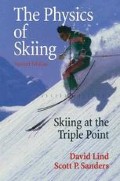Abstract
The study of skis as sliders on snow has a long history related to the more general study of friction as it affects the grinding and abrasion of moving machine parts and the most effective means of lubricating those parts. Skiing is unique among these studies because, while alpine skiers seek minimal sliding friction to increase their downhill speed, track and cross-country skiers require their skis to combine minimum and maximum friction. The running surfaces of track and cross-country skis must offer minimum friction on the forward glide and maximum trac-tional friction, or grab, when the skier pushes off against the snow for acceleration and for travel uphill. This dual, contradictory requirement makes the problem of analyzing skis as sliders on snow, and the many waxes and running surface configurations used to satisfy the need for glide and grab, very subtle. There is no definitive, scientific analysis of this problem. At best, scientific research can indicate pragmatic solutions to problems whose effectiveness must be tested in the field [1].
Access this chapter
Tax calculation will be finalised at checkout
Purchases are for personal use only
Preview
Unable to display preview. Download preview PDF.
References
S. C. Colbeck, in “A Review of the Processes that Control Snow Friction,” CRREL Monograph 92–2 (U.S. Army Corps of Engineers, Cold Regions Research and Engineering Laboratory, Hanover, NH, 1992), offers an extensive summary and review of the scientific work on this subject done to the date of his article, citing 116 references; see also his subsequent bibliography of sources on the topic, “Bibliography on Snow and Ice Friction,” CRREL Special Report No. 93–6 (U.S. Army Corps of Engineers, Cold Regions Research and Engineering Laboratory, Hanover, NH, 1993). R. Perla and B. Glenne, in their essay, “Skiing,” in Handbook of Snow, edited by D. M. Gray and D. H. Male (Pergamon, Toronto, 1981), offer excellent anecdotal advice regarding waxes and running surface configurations.
This discussion derives from the work of B. Glenne, “Sliding Friction and Boundary Lubrication of Snow,” Trans. ASME J. Tribol. 109(4), 616 (1987).
The values given are from the work of S. C. Colbeck, cited in Ref. 1 (1992).
W. Ambach and B. Mayr report these observations in “Ski Gliding and Water Film,” Cold Regions Sci. Technol. 5, 59 (1981).
G. C. Warren, S. C. Colbeck, and F. E. Kennedy report these measurements in “Thermal Response of Downhill Skis,” Report No. 89–23 (U.S. Army Corps of Engineers, Cold Regions Research and Engineering Laboratory, Hanover, NH, 1989).
Wettlaufer, John S. and J. Greg Dash, (2000) “Melting Below Zero,” Sci. Amer. 282–2, pp 58–65.
Figure 9.4 is from S. C. Colbeck’s [Ref. 1 (1992)] work on snow friction. Colbeck used a fiber block to simulate the bottom of a ski.
For example, L. Torgersen’s book, Good Glide: The Science of Ski Waxing (Human Kinetics, Champaign, IL, 1983), offers useful discussions of the techniques for waxing skis to best address a variety of conditions and performance requirements, but very little of the underlying science is considered. The “science” in the title refers mostly to practices that have been developed from extensive experience.
The literature available from commercial wax manufacturers focuses almost entirely on the “how to” and “when to” application aspects of their products. In the discussion that follows, we are indebted to one of the few scientific discussions of the chemistry of ski waxes, a monograph by G. M. Street and P. Tsui, “Composition of Glide Waxes Used in Cross Country Skiing,” (Pennsylvania State University, Biomechanics Laboratory, 1987). Glide waxes, whether they are used for alpine or for cross-country skis, are essentially the same.
This finding is reported in the monograph by G. M. Street and P. Tsui (1987) cited in Ref. 9.
M. Shimbo, in “Friction of Snow on Ski Soles, Unwaxed and Waxed,” in Scientific Study of Skiing in Japan, edited by K. Kinosita (Hitachi, Tokyo, 1971), reports coefficients of sliding and static friction as a function of wax thickness, which supports the idea that snow grains embedding in the wax base preparation is the essential phenomenon that produces traction in the grab-and-glide cycle. Interested readers should also see the discussions of ice hardness in F. P. Bowden and D. Tabor, The Friction and Lubrication of Solids (Clarendon,-Oxford, 1964), Part II.
Author information
Authors and Affiliations
Rights and permissions
Copyright information
© 2004 Springer Science+Business Media New York
About this chapter
Cite this chapter
Lind, D.A., Sanders, S.P. (2004). Friction: Glide and Grab. In: The Physics of Skiing. Springer, New York, NY. https://doi.org/10.1007/978-1-4757-4345-6_9
Download citation
DOI: https://doi.org/10.1007/978-1-4757-4345-6_9
Publisher Name: Springer, New York, NY
Print ISBN: 978-1-4419-1834-5
Online ISBN: 978-1-4757-4345-6
eBook Packages: Springer Book Archive

